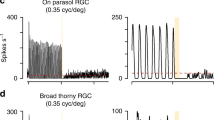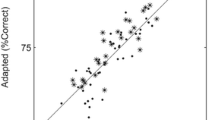Abstract
The Adelson-Bergen motion energy sensor is well established as the leading model of low-level visual motion sensing in human vision. However, the standard model cannot predict adaptation effects in motion perception. A previous paper Pavan et al.(Journal of Vision 10:1–17, 2013) presented an extension to the model which uses a first-order RC gain-control circuit (leaky integrator) to implement adaptation effects which can span many seconds, and showed that the extended model’s output is consistent with psychophysical data on the classic motion after-effect. Recent psychophysical research has reported adaptation over much shorter time periods, spanning just a few hundred milliseconds. The present paper further extends the sensor model to implement rapid adaptation, by adding a second-order RC circuit which causes the sensor to require a finite amount of time to react to a sudden change in stimulation. The output of the new sensor accounts accurately for psychophysical data on rapid forms of facilitation (rapid visual motion priming, rVMP) and suppression (rapid motion after-effect, rMAE). Changes in natural scene content occur over multiple time scales, and multi-stage leaky integrators of the kind proposed here offer a computational scheme for modelling adaptation over multiple time scales.







Similar content being viewed by others
References
Adelson, E. H., & Bergen, J. R. (1985). Spatiotemporal energy models for the perception of motion. Journal of the Optical Society of America A, 2, 284–299.
Amit, D. J. (1989). Modeling brain function. New York: Cambridge University Press.
Arnold, D. H., & Clifford, C. W. (2002). Determinants of asynchronous processing in vision. Proceedings of the Royal Society of London, B269, 579–583.
Bergen, J. R., & Wilson, H. R. (1985). Prediction of flicker sensitivities from temporal three pulse data. Vision Research, 25, 577–582.
Boudreau, C. E., & Ferster, D. (2005). Short-term depression in thalamocortical synapses of cat primary visual cortex. Journal of Neuroscience, 25, 7179–7190.
Buchel, C., Josephs, O., Rees, G., Turner, R., Frith, C. D., & Friston, K. J. (1998). The functional anatomy of attention to visual motion. A functional MRI study. Brain, 121, 1281–1294.
Castro-Alamancos, M., & Connors, B. W. (1996). Short-term synaptic enhancement and long-term potentiation in neocortex. Proceedings of the National Academy of Sciences of the United States of America, 93, 1335–1339.
Cavanagh, P. (1992). Attention based motion perception. Science, 257, 1563–1565.
Challinor, K. L., & Mather, G. (2010). A motion-energy modelpredicts the direction discrimination and MAE duration of two-stroke apparent motion at high and low retinal illuminance. Vision Research, 50, 1109–1116.
Chance, F. S., Nelson, S. B., & Abbott, L. F. (1998). Synaptic depression and the temporal response characteristics of V1 cells. Journal of Neuroscience, 18, 4785–4799.
Culham, J., Verstraten, F. A. J., Ashida, H., & Cavanagh, P. (2000). Independent aftereffects of attention and motion. Neuron, 28, 607–615.
Daelli, V., & Treves, A. (2010). Neural attractor dynamics in object recognition. Experimental Brain Research, 203, 241–248.
Daelli, V., van Rijsbergen, N., & Treves, A. (2010). How recent experience affects the perception of ambiguous objects. Brain Research, 1322, 81–91.
Emerson, R. C., Bergen, J. R., & Adelson, E. H. (1992). Directionally selective complex cells and the computation of motion energy in cat visual cortex. Vision Research, 32, 203–218.
Fuortes, M. G., & Hodgkin, A. L. (1964). Changes in time scaleand sensitivity in the ommatidia of Limulus. Journal of Physiology, 172, 239–263.
Georgeson, M. A., & Scott-Samuel, N. E. (1999). Motion contrast: a new metric for direction discrimination. Vision Research, 39, 4393–4402.
Giaschi, D., Douglas, R., Marlin, S., & Cynader, M. (1993). The time course of direction-selective adaptation in simple and complex cells in cat striate cortex. Journal of Neurophysiology, 70, 2024–2034.
Glasser, D. M., Tsui, J. M. G., Pack, C. C., & Tadin, D. (2011). Perceptual and neural consequences of rapid motion adaptation. Proceedings of the National Academy of Sciences of the United States of America, 108(45).
Finlayson, P. G., & Cynader, M. S. (1995). Synaptic depression in visual cortex tissue slices: An in vitro model for cortical neuron adaptation. Experimental Brain Research, 106, 145–155.
Groppe, D. M., Urbach, T. P., & Kutas, M. (2011). Mass univariate analysis of event-related brain potentials/fields I: A critical tutorial review. Psychophysiology, 48(12), 1711–1725.
Haug, B. A., Baudewig, J., & Paulus, W. (1998). Selective activation of human cortical area V5A by a rotating visual stimulus in fMRI; implication of attentional mechanisms. Neuroreport, 9, 611–614.
Hershenson, M. (1993). Linear and rotation motion aftereffects as a function of inspection duration. Vision Research, 33, 1913–1919.
Hempel, C. M., Hartman, K. H., Wang, X.-J., Turrigiano, G. G., & Nelson, S. B. (2000). Multiple forms of short-term plasticity at excitatory synapses in rat medial prefrontal cortex. Journal of Neurophysiology, 83, 3031–3941.
Holm, S. (1979). A simple sequentially rejective multiple test procedure. Scandinavian Journal of Statistics, 6, 65–70.
Huk, A. C., Ress, D., & Heeger, D. J. (2001). Neuronal basis of the motion aftereffect reconsidered. Neuron, 32, 161–172.
Kanai, R., & Verstraten, F. A. (2005). Perceptual manifestations of fast neural plasticity: Motion priming, rapid motion aftereffect and perceptual sensitization. Vision Research, 45, 3109–3116.
Lingnau, A., Ashida, H., Wall, M. B., & Smith, A. T. (2009). Speed encoding in human visual cortex revealed by fMRI adaptation. Journal of Vision, 9(13), 1–14. 3.
Lisberger, S., & Movshon, J. (1999). Visual motion analysis for pursuit eye movements in area MT of macaque monkeys. Journal of Neuroscience, 19, 2224–2246.
Mather, G., Pavan, A., Campana, G., & Casco, C. (2008). The motion aftereffect reloaded. Trends in Cognitive Sciences, 12, 481–487.
Moutoussis, K., & Zeki, S. (1997). A direct demonstration of perceptual asynchrony in vision. Proceedings of the Royal Society of London B, 264(1380), 393–399.
Nelson, S. B. (1991). Temporal interactions in the cat visual system: I. Orientation-selective suppression in the visual cortex. Journal of Neuroscience, 11, 344–356.
Pavan, A., Campana, G., Guerreschi, M., Manassi, M., & Casco, C. (2009). Separate motion-detecting mechanisms for first- and second-order patterns revealed by rapid forms of visual motion priming and motion aftereffect. Journal of Vision, 27, 1–16.
Pavan, A., Campana, G., Maniglia, M., & Casco, C. (2010). The role of high-level visual areas in short- and longer-lasting forms of neural plasticity. Neuropsychologia, 48, 3069–3079.
Pavan, A., Contillo, A., & Mather, G. (2013). Modelling adaptation to directional motion using the Adelson-Bergen energy sensor. PloS One, 8(3), e59298.
Pavan, A., & Skujevskis, M. (2013). The role of stationary and dynamic test patterns in rapid forms of motion aftereffect. Journal of Vision, 10, 1–17.
Pinkus, A., & Pantle, A. (1997). Probing visual motion signals with a priming paradigm. Vision Research, 37, 541–552.
Priebe, N. J., Churchland, M. M., & Lisberger, S. G. (2002). Constraints on the source of short-term motion adaptation in macaque area MT: I. The role of input and intrinsic mechanisms. Journal of Neurophysiology, 88, 354–369.
Priebe, N. J., & Lisberger, S. G. (2002). Constraints on the source of short-term motion adaptation in macaque area MT II. Tuning of neural circuit mechanisms. Journal of Neurophysiology, 88, 370–382.
Rainville, S. J., Makous, W. L., & Scott-Samuel, N. E. (2005). Opponent-motion mechanisms are self-normalizing. Vision Research, 45, 1115–1127.
Rainville, S. J., Scott-Samuel, N. E., & Makous, W. L. (2002). The spatial properties of opponent-motion normalization. Vision Research, 42, 1727–1738.
Rees, G., Frith, C. D., & Lavie, N. (1997). Modulating irrelevant motion perception by varying attentional load in an unrelated task. Science, 278, 1616–1619.
Rolls, E. T. (1989). The representation and storage of information in neuronal networks in the primate cerebral cortex and hippocampus. In R. Durbin, C. Miall, & G. Mitchison (Eds.), The computing neuron, Ch. 8 (pp. 125–159). England: Addison-Wesley, Wokingham.
Rushton, W. A. H. (1962). Visual adaptation. Proceedings of the Royal Society B, 986, 20–46.
Seidemann, E., & Newsome, W. T. (1999). Effect of spatial attention on the responses of area MT neurons. Journal of Neurophysiology, 81, 1783–1794.
Stratford, K. J., Tarczy-Hornuch, K., Martin, K. A. C., Bannister, N. J., & Jack, J. J. B. (1996). Excitatory synaptic inputs to spiny stellate cells in cat visual cortex. Nature, 382, 258–261.
Strout, J. J., Pantle, A., & Mills, S. L. (1994). An energy model of interframe interval effects in single-step apparent motion. Vision Research, 34, 3223–3240.
Takeuchi, T., & De Valois, K. K. (1997). Motion-reversal reveals two motion mechanisms functioning in scotopic vision. Vision Research, 37, 745–755.
Taylor, M. M. (1963). Tracking the decay of the after-effect of seen rotary movement. Perceptual and Motor Skills, 16, 119–129.
Treue, S., & Maunsell, J. H. (1996). Attentional modulation of visual motion processing in cortical areas MT and MST. Nature, 382, 539–541.
Treue, S., & Maunsell, J. H. (1999). Effects of attention on the processing of motion in macaque middle temporal and medial superior temporal visual cortical areas. Journal of Neuroscience, 19, 7591–7602.
van de Grind, W. A., Lankheet, M. J. M., & Tao, R. (2003). A gain-control model relating nulling results to the duration of dynamic motion aftereffects. Vision Research, 43, 117–133.
Vautin, R. G., & Berkley, M. A. (1977). Responses of single cells in cat visual cortex to prolonged stimulus movement: neural correlates of visual aftereffects. Journal of Neurophysiology, 40, 1051–1065.
Varela, J. A., Song, S., Turrigiano, G. G., & Nelson, S. B. (1999). Differential depression at excitatory and inhibitory synapses in visual cortex. Journal of Neuroscience, 19(11), 4293–4304.
Verstraten, F. A. J., & Ashida, H. (2005). Attention-based motion perception and motion adaptation: What does attention contribute? Vision Research, 45, 1313–1319.
Wark, B., Fairhall, A., & Rieke, F. (2009). Timescales of inference in visual adaptation. Neuron, 61(5), 750–761.
Zengel, J. E., & Magleby, K. L. (1982). Augmentation and facilitation of transmitter release. A quantitative description at the frog neuromuscular junction. Journal of General Physiology, 80, 583–611.
Acknowledgments
Author AP was supported by grants from the Alexander von Humboldt Foundation, Author AC was supported by the Deutsche Forschungsgemeinschaft (DFG) within the Emmy-Noether program (Grant SA/1975 1–1) and by the Università degli Studi di Ferrara, Author GM was supported by the University of Lincoln.
Conflict of interest
The authors declare that they have no conflict of interest.
Author information
Authors and Affiliations
Corresponding author
Additional information
Action Editor: Alessandro Treves
Rights and permissions
About this article
Cite this article
Pavan, A., Contillo, A. & Mather, G. Modelling fast forms of visual neural plasticity using a modified second-order motion energy model. J Comput Neurosci 37, 493–504 (2014). https://doi.org/10.1007/s10827-014-0520-x
Received:
Revised:
Accepted:
Published:
Issue Date:
DOI: https://doi.org/10.1007/s10827-014-0520-x




